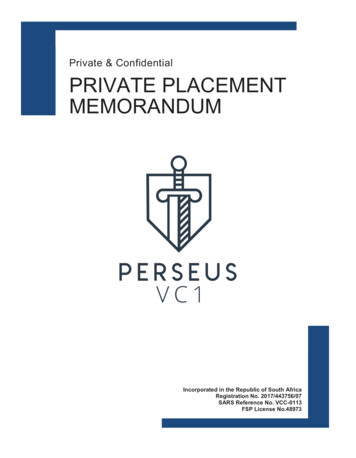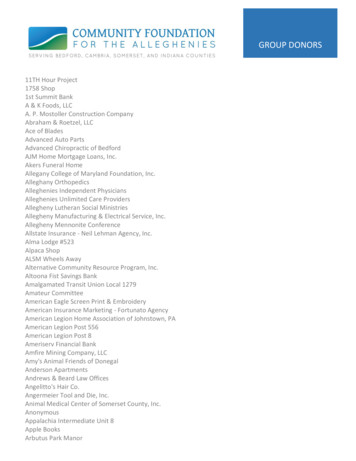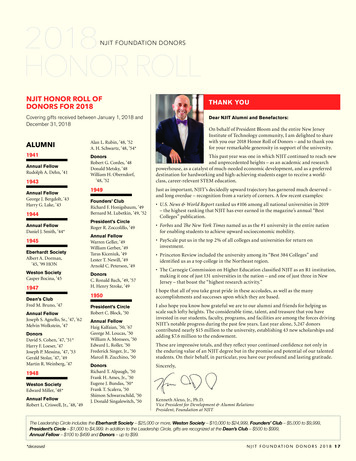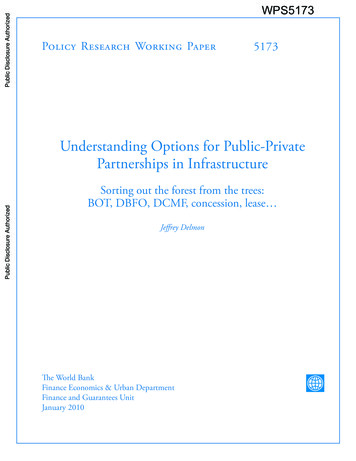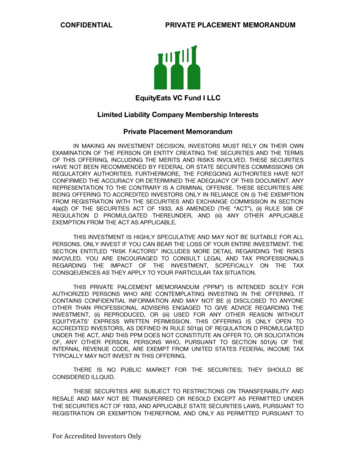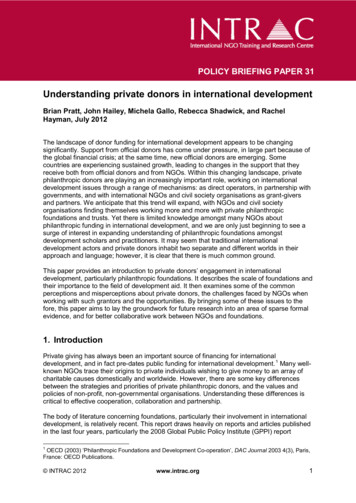
Transcription
POLICY BRIEFING PAPER 31Understanding private donors in international developmentBrian Pratt, John Hailey, Michela Gallo, Rebecca Shadwick, and RachelHayman, July 2012The landscape of donor funding for international development appears to be changingsignificantly. Support from official donors has come under pressure, in large part because ofthe global financial crisis; at the same time, new official donors are emerging. Somecountries are experiencing sustained growth, leading to changes in the support that theyreceive both from official donors and from NGOs. Within this changing landscape, privatephilanthropic donors are playing an increasingly important role, working on internationaldevelopment issues through a range of mechanisms: as direct operators, in partnership withgovernments, and with international NGOs and civil society organisations as grant-giversand partners. We anticipate that this trend will expand, with NGOs and civil societyorganisations finding themselves working more and more with private philanthropicfoundations and trusts. Yet there is limited knowledge amongst many NGOs aboutphilanthropic funding in international development, and we are only just beginning to see asurge of interest in expanding understanding of philanthropic foundations amongstdevelopment scholars and practitioners. It may seem that traditional internationaldevelopment actors and private donors inhabit two separate and different worlds in theirapproach and language; however, it is clear that there is much common ground.This paper provides an introduction to private donors’ engagement in internationaldevelopment, particularly philanthropic foundations. It describes the scale of foundations andtheir importance to the field of development aid. It then examines some of the commonperceptions and misperceptions about private donors, the challenges faced by NGOs whenworking with such grantors and the opportunities. By bringing some of these issues to thefore, this paper aims to lay the groundwork for future research into an area of sparse formalevidence, and for better collaborative work between NGOs and foundations.1. IntroductionPrivate giving has always been an important source of financing for internationaldevelopment, and in fact pre-dates public funding for international development. 1 Many wellknown NGOs trace their origins to private individuals wishing to give money to an array ofcharitable causes domestically and worldwide. However, there are some key differencesbetween the strategies and priorities of private philanthropic donors, and the values andpolicies of non-profit, non-governmental organisations. Understanding these differences iscritical to effective cooperation, collaboration and partnership.The body of literature concerning foundations, particularly their involvement in internationaldevelopment, is relatively recent. This report draws heavily on reports and articles publishedin the last four years, particularly the 2008 Global Public Policy Institute (GPPI) report1OECD (2003) ‘Philanthropic Foundations and Development Co-operation’, DAC Journal 2003 4(3), Paris,France: OECD Publications. INTRAC 2012www.intrac.org1
‘Transforming Development? The Role of Philanthropic Foundations in InternationalDevelopment Cooperation’; the 2012 Nuffield Foundation’s ‘Global Grant-Making: A Reviewof the UK Foundations’ Funding for International Development’, and the report from theUnited Kingdom House of Commons International Development Committee on ‘PrivateFoundations’ in 2012. Mention must also be made of the work of the New York-basedFoundation Center, the European Foundation Centre (EFC) and the various publications ofthe Bellagio Initiative into the Future of Philanthropy and Development. The reflections in thisbriefing paper also draw on insights from the work of INTRAC, its associates, and partnerswith private foundations. 22. Who are private philanthropic donors?Initially, many NGOs relied on support from individual gift giving, personal donations andchild sponsorship, but over the last three decades or so, NGO income came increasinglyfrom official governmental donors using tax-based funding – for example, the DanishInternational Development Agency (DANIDA), the UK’s Department for InternationalDevelopment (DFID), the Swedish International Development Cooperation Agency (SIDA),the Canadian International Development Agency (CIDA), or the US Agency for InternationalDevelopment (USAID). However, in recent years there has been growth in new or alternativeways of generating funding and new sources of financial support for NGOs, including: Web-based personal giving, including: web-based fund channelling sites, e.g.Guidestar, Razoo, GivingWhatWeCan, GivingWell; or investment channelling sites(kiva.org)Income-generating activities, such as tied-trading businesses (e.g. Oxfam Trading,BRAC Bank), commissions and contracts (e.g. Technoserve), or new franchisingbased social enterprises (e.g. the Kenyan-based Sidai)Community initiatives, e.g. the new range of Community DevelopmentFoundations, or local funding through twinning or partnering arrangementsTrusts born of public fundraising, but privately administered, e.g. Comic Relief, UKBig LotteryPrivate philanthropic donors giving through an increasingly diverse range of familyfoundations and social investment initiatives, including established foundations (Fordor Rockefeller Foundations) or new philanthropic ventures such as those run byAbsolute Return for Kids (ARK), Atlantic Philanthropies or the Children’s InvestmentFund Foundation (CIFF). 3Of the wide array of actors that can be characterised as private philanthropic donors, thispaper focuses on the role of different philanthropic foundations, including individual or familyfoundations, corporate foundations (the philanthropic ‘wings’ of companies, banks, etc.),community foundations and private associations. The following section provides an overviewof definitions of such foundations found in the literature, and offers a working definition of‘private philanthropic donors’.A recent UK House of Commons report distinguishes ‘private foundations’ from charities orcharitable foundations, as they do not generally seek out funding from the general public,companies or government. Foundations, it states, are usually a legal entity established by anindividual or group for philanthropic purposes. They therefore define foundations as “nongovernmental, non-profit organisations that possess a principal fund of their own and are self2As much of this work is undertaken in confidence, we have often not made reference to specificfoundations, their benefactors or programmes.3Hailey, J. (2011a) ‘Notes on New Private Donors: Foundations and NGOs’, presented at the INTRACNGO Forum, Oxford, UK, 24–25 May 2011. INTRAC 2012www.intrac.org2
managed by a board of trustees.” 4 The Nuffield Foundation’s commissioned 2012 study on‘Global Grant Making’ identified foundations and trusts, as “independent grantmakingcharities, whose income derives mainly from private sources”. 5 The 2011 studycommissioned by Global Institutional Philanthropy for the Worldwide Initiatives forGrantmaker Support (WINGS) and The Philanthropic Initiative (TPI) categorisedphilanthropic foundations into independent, corporate and community foundations (includingmulti-purpose fundraising organisations set up to serve particular sectors), and governmentlinked foundations. 6 This paper highlighted the point that public sector funding to foundationsneeded to be distinguished from philanthropic donations from private donors, and thatremittances from diaspora populations constitutes a form of private action for development. 7Foundations can be categorised in several ways, for instance by sector or geographic origin,by age or generation, by size or scale (e.g. size of endowment, assets or annual giving), bysource of funding (e.g. endowment vs. corporate profits) or by approach and level ofengagement (e.g. funding support/grantmaker or venture philanthropy/funding). 8 The use ofthese different categories, while making comparative studies problematic, allowsresearchers and grantees to develop a working typology of value to their own needs orpriorities. 9 It should also be noted that definitions and approaches to categorisation varydepending on different legal and regulatory regimes and the cultural context in which thefoundation is established. For example, as Tadros notes, any understanding of the role ofIslamic philanthropy and foundations registered in Muslim countries “requires a shift fromexamining the phenomenon through the lens of Western philanthropic trajectories to onerecognising the role of philanthropy in a much wider and broader conception of the divisionof labour and the organisation of the Muslim Ummah (nation)”. 10The European Foundation Centre (EFC) accepts that definitions of ‘foundation’ vary acrossEurope and so focuses on the role of what they call ‘public-benefit foundations’, which itdefines as being “asset-based and purpose-driven have no members or shareholders andare separately-constituted non-profit bodies [and] have an established and reliableincome source ”. 11 The US-based Foundation Center recognises the diversity offoundational types, and so defines foundations by whether they are independent (families,individuals, and health-care conversions), corporate (funded through profit or proportion ofturnover), or community foundations (which are based on collective funding drawn from abroad pool of linked-individual donors). 124The International Development Committee (2012a) ‘Private Foundations – Thirteenth Report of Session2010–12; Volume I: Report, together with formal minutes, oral and written evidence’, London, UK: House ofCommons: Ev555Pharoah, C. and L. Bryant (2012) ‘Global Grant-making: A Review of UK Foundations’ Funding forInternational Development’, London, UK: Nuffield Foundation: 96Johnson, P. D. (2011) ‘Global Institutional Philanthropy: A Preliminary Status Report’, Boston, MA, USA:The Philanthropic initiative (TPI), and Brussels, Belgium: Worldwide Initiatives for Grantmaker Support(WINGS).7Davis, K. E. and S. Dadush (2010) ‘The Privatization of Development Assistance: Symposium Overview’,New York, USA: New York University Law and Economics Working Papers, Paper 218.8IVAR (2011) ‘Beyond Money: A Study of Funding Plus in the UK’, London, UK: Institute of VoluntaryAction Research.9Hailey 2011a10Tadros, M. (2011) ‘Islamic Philanthropy and Wellbeing”, Bellagio Briefing Summary, IDS, Sussex, UK:Bellagio Initiative.11EFC (2008) ‘Foundations in the European Union, Facts and Figures: Report on work by EFC ResearchTask Force’, Brussels, Belgium: European Foundation Centre: 312Foundation Center (2011) ‘Highlights of Foundation Yearbook, 2011 Edition’, Foundations Today series,New York: Foundation Center; Lawrence, S. and R. Mukai (2011) ‘Foundation Growth and GivingEstimates, Current Outlook, 2011 Edition’, Foundations Today series, New York, NY, USA: FoundationCenter. INTRAC 2012www.intrac.org3
Drawing on these definitions, and others, some common characteristics emerge. 13 For thepurposes of this paper, private philanthropic foundations can be characterised by having: charitable or philanthropic intentions, usually to address issues of common social,economic or geographic interest founders with charitable or social intentions, e.g. individuals, families, companies,communities, specialist interest groups or associations their own income and funds, which are privately raised, in other words notthrough public sector grants a public benefit role – either as grantors funding other organisations, or beingdirectly operational, i.e. implementing their own projects or in collaboration orpartnership with others a philanthropic legal status, e.g. as a trust or not-for-profit organisation independent governance structures (boards, trustees, etc.).3. Private donor involvement in international developmentThe economic crisis that erupted in 2008 and the consequent pressure on governmentbudgets have had significant consequences for aid funding, particularly government-fundedofficial development assistance (ODA). This has led aid organisations to seek out alternativefunding, and the role of private donors in aid funding has consequently increased inimportance. Many private foundations have their own long-established presence in theinternational development field, e.g. the Ford Foundation or the Wellcome Trust; whilst someare more recent, e.g. the Bill and Melinda Gates Foundation or the Sigrid Rausing Trust.However, it is clear that most foundations and private philanthropic donors focus on giving ata local or national level, and that only a limited proportion of total philanthropic giving goes tointernational development. 14 This section provides some information on the financial givingof those foundations involved in such international development.The research suggests that much of the money from such private philanthropic donors ischannelled through NGOs rather than government or multilateral agencies. 15 However, it isdifficult to know exactly how much money is going to what, from whom and through whom; itis hard to access aggregate funding data to get an overview of the level of funding by privatephilanthropic donors for international development. Analysis of such data is complicatedbecause of the variety of definitions used (i.e. because of legal and cultural differences as towhat is a foundation – in some cases these include government-funded foundations), andthe different economic contexts in which they operate. It is clear that more research isneeded in this area and more comparative analysis of the level of funding to NGOs fromprivate philanthropic donors and foundations.13See also: Resource Alliance (2011) ‘Philanthropy: Current Context and Future Outlook’, Bellagio Report,IDS, Sussex, UK: Bellagio Initiative; Marten, R. and J. M. Witte (2008) ‘Transformi
Absolute Return for Kids (ARK), Atlantic Philanthropies or the Children’s Investment Fund Foundation (CIFF).3 Of the wide array of actors that can be characterised as private philanthropic donors, this paper focuses on the role of different philanthropic foundations, including individual or family
